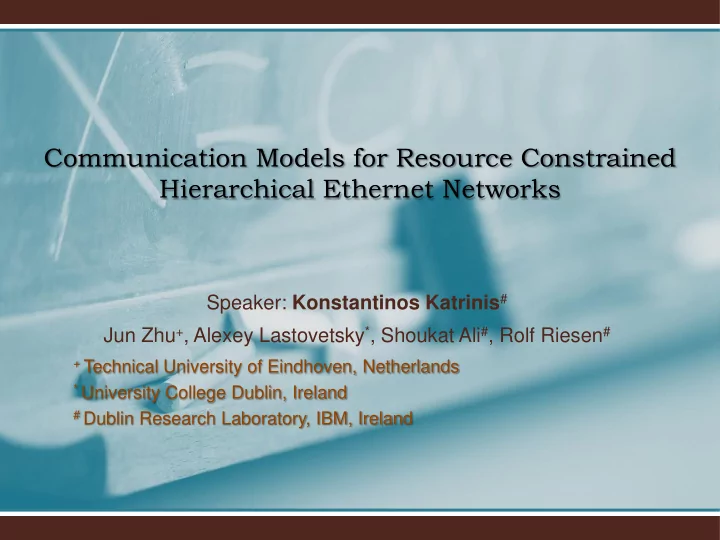

Communication Models for Resource Constrained Hierarchical Ethernet Networks Speaker: Konstantinos Katrinis # Jun Zhu + , Alexey Lastovetsky * , Shoukat Ali # , Rolf Riesen # + Technical University of Eindhoven, Netherlands * University College Dublin, Ireland # Dublin Research Laboratory, IBM, Ireland
Outline • Introduction • Related work • Network properties • Communication model • Experiments • Conclusion 2
Introduction • Cost effective yet powerful computer cluster – COTS computers: multi-core to many-core – Ethernet vs. custom interconnects – Shared resources: network and memory – Open-source software stack: Linux and OpenMPI • Concerns in cluster-based parallel computing – Computers are tightly coupled – Communication models are non-trivial 3
Testbed Cluster • Two star-configured racks connected via backbone • Communication contention happens on different levels – Network interface cards (NICs) – Backbone cable • Communication times prediction is hard yet important 4
Goals and Contributions • To derive network properties on parameterized network topology from simultaneous point-to-point MPI operations • Our work is the first effort to discover the asymmetric network property on TCP layer for concurrent bidirectional communications • To propose communication models for concurrent communications in resource-constrained Ethernet clusters • We show that the communication time predictions become significantly less accurate, if the asymmetric network property is excluded from the model 5
Related Work No network contention • Hockney model [PMPC 94]- point-to-point communication time for a message with size m is: a + m*b , where a is latency and b inversed bandwidth • Similar models: LogP [Culler 93] for small messages and LogGP [Hoefler 06] Network contention-aware • A recent communication model [Martinasso 11] considers NIC level contention for InfiniBand clusters Our proposed model for Ethernet clusters, with – NIC and backbone levels contention-aware – Asymmetric communication property - from benchmarking 6
MPI Micro-benchmark • Point-to-point MPI benchmarking • A 95% confidence level of averaged timings • Setup for any given number of simultaneous communications
Platform & Specification • Up to 15 nodes (RHEL 5.5 x86-64) in each rack o Dual-socket six-core (Intel Xeon X5670 6C@2.93GHz) o 1Gb NIC tuned, ToR IBM BNT Rack Switch G8264 1-10Gb • OpenMPI 1.5.4 as the MPI Implementation • Large message sizes (10MB)in benchmarking 8
Network Property - Fairness To set unidirectional communication for |E| number of point-to-point MPI operations in testbed A. Intra-rack communication: sender on the same node B. Inter-rack communication: sender on different nodes We expect • Bandwidth is fairly distributed over all links • In experiment B,when |E| is bigger enough, the bandwidth of the backbone may saturate 9
Network Property – Fairness (contd.) Verified properties for unidirectional communication • Fairness • Network saturation Fig. Average bandwidth of unidirectional logical links on a optical backbone Formal model: 10
Network Property - Asymmetric • To study bidirectional communication, we swap the mapping policy for some of the sender and receiver processes in the previous experiments • We expect the previous properties hold, i.e. fairness and network saturation • However, an asymmetric property appears, which has not yet been reported in the literature. • Iperf has been used to verify the property, and we double-check in a different Ethernet cluster in HCL laboratory in UCD. 11
Network Property – Asymmetric (contd.) For instance, when δ + (·) = 2 and δ − (·) = 1, i.e. two incoming and one outgoing links • The outgoing link should get 940Mbps bandwidth, according to a fair dynamic bandwidth allocation in full • However, it gets 470Mbps , the same as incoming links Fig. Average bandwidth for bidirectional logical links on a NIC Formal model: 12 12
Communication Model
Times Prediction • The communication times depend on message sizes and the derived communication bandwidth of logical links, as in [Martinasso 11]. • the bandwidth of logical links may be redistributed dynamically. • The predicted communication time Ta,b for each communication operation is Algorithm - to predict the time required for calculated until all logical links are each communication operation analyzed. 14
Experiments • Cluster has been configured with 1 GbE for intra-rack and 10 GbE for inter-rack communication • Each time the same number of nodes are configured in both racks, with a total nodes |N | up to 30 15
Experimental Results • Fig. Histogram of times prediction errors. • 9 experiments with a set of values for parameters |N| and d • A total of 354 randomly generated communication patterns are tested • The prediction error with pure fairness property: can be as worse as −80%, i.e. predicted times are 5 times lower than the measured ones • Our model is quite accurate: worst averaged 9.5%, and much better worse case 16 (−50%, no more than 2 times difference)
Conclusion & Future Work Conclusion: • We derive an ‘asymmetric network property’ on TCP layer for concurrent bidirectional communications on Ethernet clusters • We develop a communication model to characterize the communication times on resource constrained networks accordingly. • We conduct statistically rigorous experiments to show that our model can be used to predict the communication times for simultaneous MPI operations effectively, only when asymmetric network property is considered. Conclusion: • As the future work, we plan to generalize our model for more complex network topologies. • On the other hand, we would also like to investigate how the asymmetric network property can be tuned below TCP layer in Ethernet networks. 17
Thank you! Questions?
Recommend
More recommend